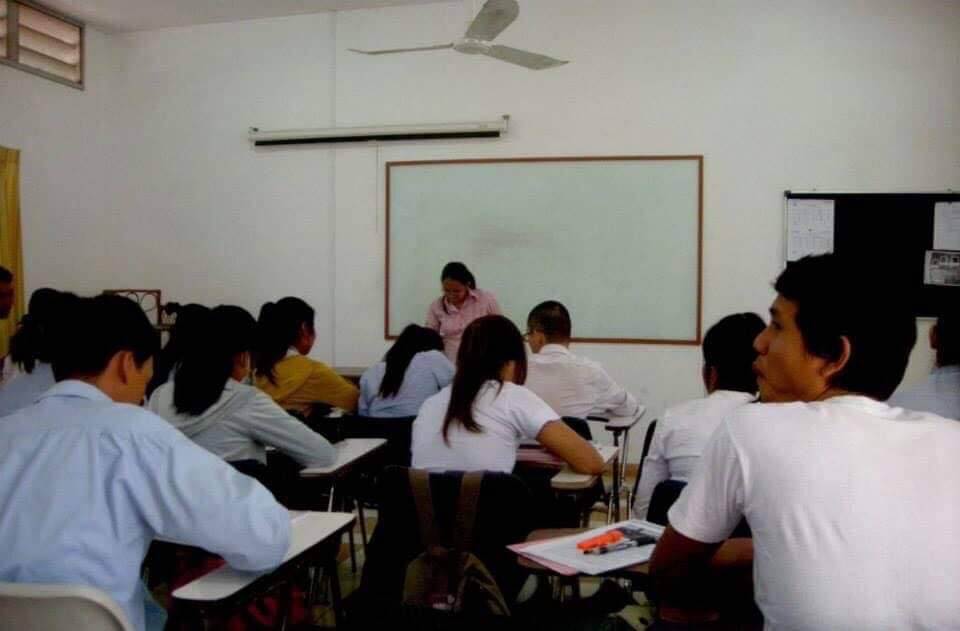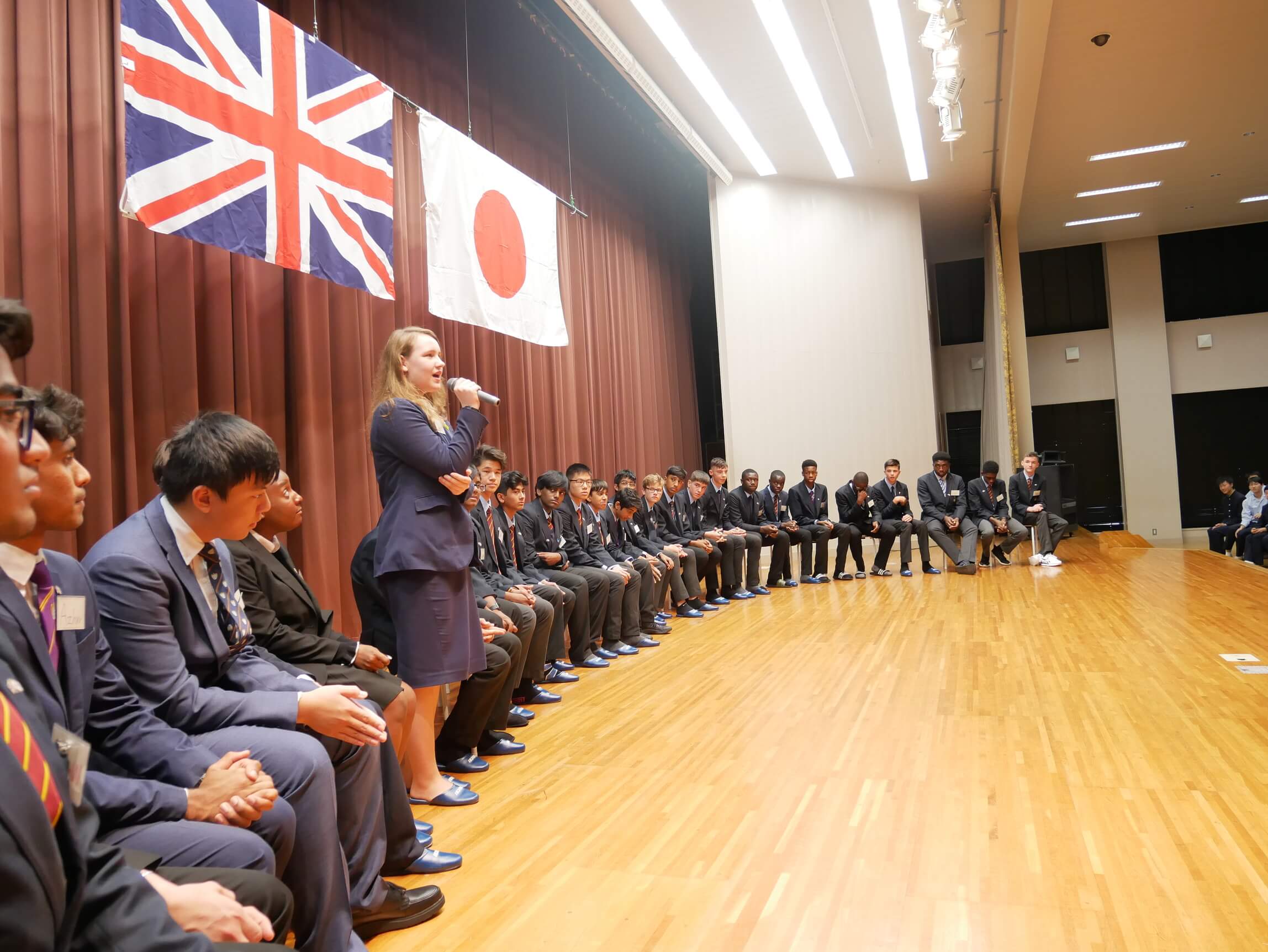2022.11.17
LANGUAGEHelping Cherry Blossoms Bloom the World Over: Developing a Global Network of Japanese Language Institutions

A group of students participating in the Noh mask workshop as part of the “Creativity Week Japanese Culture Days.” This event was held at Dartford Grammar School, in cooperation with the Japan Foundation, London. Photo: ©Dartford Grammar School
The JF Nihongo Network connects core educational institutions that teach Japanese throughout the world. This project, nicknamed the “Sakura Network,” has developed a sense of solidarity that transcends educational levels—primary, secondary, or post-secondary—as well as national boundaries.
The Japan Foundation (JF) works closely with Japanese language institutions overseas to improve the quality of Japanese language education and provide more people with opportunities to learn Japanese. The development of the JF Nihongo Network (also known as the “Sakura Network”), which has been ongoing since 2007, is a part of this effort.
As of the end of March 2022, the network consists of 357 member institutions from 102 countries and regions throughout the world. Supporting local educational institutions is essential in developing Japanese language education in various countries and regions. This network allows educational institutions to receive support from institutions in the same country, neighboring countries, and beyond—even in areas where JF Japanese-language specialists have not yet been dispatched.
Requirements for joining the Sakura Network include having a solid organizational foundation and a satisfactory track record of past activities. Institutions are also evaluated for their ability to inspire the local community and expand the Japanese language education. Once approved, JF will provide the institution with support in the form of grants for various activities, including for the preparation of educational materials.
Cambodia — Traveling around Rural Areas to Promote Japanese Culture
In 2007, the Royal University of Phnom Penh in Cambodia joined the Sakura Network. Ms. Loch Leaksmy, Deputy Director of the Institute of Foreign Languages, was instrumental in the establishment of the Department of Japanese at the university. Ms. Leaksmy began her Japanese language education through self-study, then, after entering the same university at which she now works, completed a non-credit extracurricular Japanese language course taught by a member of the Japan Overseas Cooperation Volunteers (JOCV), and then becoming an employee of the university following her graduation. She later underwent further study of teaching methods along with other subjects, and became a Japanese language teacher. At the time, however, there was little growth in the number of students studying Japanese in the extracurricular courses offered at the school.
Ms. Leaksmy thus went directly to the rector of the university to request the establishment of a Japanese language department. As a result, the Department of Japanese was established at the university in 2003, with full-fledged classes beginning two years later. In 2005, there were 85 students across three classes. Now, there are 650 students across 24 classes. Ms. Leaksmy says, “Some of our graduates have gone on to work for Cambodia’s Ministry of Foreign Affairs and International Cooperation, while others have been deployed to the Royal Embassy of Cambodia in Japan.”

Ms. Leaksmy teaching a class on Japanese affairs to third-year students at the Royal University of Phnom Penh in 2013.
The university has reaped significant benefits from joining the Sakura Network. One such example is the “Sakura Caravan for Promoting Japanese Language Education and Culture,” which the university hosted in February 2020 as a project under the Sakura Network (co-organized by the Embassy of Japan in Cambodia). The project had teams of Japanese residents and working adults, including graduates of the university, traveling around the region to teach Japanese and introduce Japanese culture to local communities. When explaining the significance of this, Ms. Leaksmy said “Hearing the stories that came out of the caravan, students in secondary school or below were able to envision a future in which they could study abroad or even find a job by studying Japanese. It was great to be able to connect to the younger generation in rural areas, where there are no Japanese language institutions.”

Ms. Loch Leaksmy. Graduated from the Royal University of Phnom Penh in 1997. Founder of the university’s Department of Japanese. Received her master’s degree in Japanese Education at the Showa Women’s University in 2005 and completed her doctoral research in Language and Communication Studies at the Graduate School of Literature in 2016. Currently the Deputy Director of the Institute of Foreign Languages at the Royal University of Phnom Penh.
United Kingdom — Japanese as an Option for Nurturing “Global Citizens”
Dartford Grammar School, a secondary school in the United Kingdom, joined the Sakura Network in 2016. The school, founded in 1576, attracts the best and brightest students in the area. What sets the school apart is its mission to nurture “global citizens,” as well as its emphasis on language education. The curriculum is based on the International Baccalaureate (IB), a program that grants universal university entrance qualifications and transcripts. The IB includes a Japanese language examination for both native and non-native speakers.

Dartford Grammar School is a state school located in Kent, approximately 25 kilometers southeast of London. Photo:©Dartford Grammar School
The school began offering Japanese language education in 1995 and requires students to take two foreign language exams (either Japanese or Chinese, alongside either French, German, Spanish, or Latin) for the General Certificate of Secondary Education (GCSE), a secondary school academic qualification. Mrs. Katy Simpson, Head of Japanese and Sakura Network Manager, explains the reason behind this requirement: “The overall philosophy of the school is one of communication and respect. In order to be a global citizen who brings peace to the world, diversity is an important component. That’s why we emphasize language education, and why I think it’s good for students to learn about the cultural aspects of languages, such as the artistic element of learning the kanji characters, as well as the logic of Japanese grammar.”
Students study Japanese from Year 7 (12 years old) to Year 13 (18 years old), with classes held three times a week. Students are assigned to either Japanese or Chinese language classes by the school when they enter as Year 7 students in September. By Christmas of the same year, those assigned to Japanese will have mastered hiragana and katakana. An exchange program is also held every year with two high schools in Wakayama Prefecture. In this program, students enjoy a homestay experience for 10 days with local families, and spend time at their counterparts’ schools, taking classes, participating in club activities, and traveling to nearby areas.

Dartford Grammar School offers exchange programs with Wakayama Prefectural Koyo High School and Kaichi Junior / Senior High School, in cooperation with Wakayama Prefecture NPOs, the Wakayama Branch of the Japan Foundation for Intercultural Exchange, and the Wakayama International Exchange Promotion Association. This photo shows a welcome ceremony from when students visited Kaichi Junior / Senior High School in 2018. Photo: ©Dartford Grammar School
“Joining the Sakura Network has definitely opened so many doors for us. We’ve been able to interact with other educational institutions on a wider scale, and connect with lots of scholars and researchers,” says Mrs. Simpson. Mr. Julian Metcalf, Head of Dartford Grammar School says, “It’s very unusual in the U.K. context to be able to study Western and Eastern languages together like this. We want to continue making efforts to introduce Japan and the Japanese language on a broader scale—not just to our own students, but to those of our local elementary and junior high schools as well.”

Mr. Julian Metcalf, Head of Dartford Grammar School. “We’re always looking for excellent Japanese language teachers. We want to continue enhancing and expanding our Japanese language classes,” Mr. Metcalf says. Photo: ©Dartford Grammar School

Mrs. Katy Simpson, Head of Japanese and Sakura Network Manager. Teaches Japanese at Dartford Grammar School. Used to live in Nagano Prefecture and Tokyo. Photo: ©Dartford Grammar School
There are several challenges that the Sakura Network must address. One is increasing the number of member institutions in Africa. JF is providing coordination and cooperation to teachers involved in Japanese language education in African countries such as Kenya in order to support the development of a Japanese language network. Seventy such teachers from 13 countries in Africa participated in the 1st African Conference on Japanese-Language Education, held in Ethiopia in 2019. The development of a broader network for Central America and the Caribbean is also underway. There, the Japan Foundation, Mexico has taken the lead in organizing seminars, symposiums, and online conferences that bring together Japanese teachers from countries such as El Salvador, Nicaragua, Costa Rica, and the Dominican Republic.
With initiatives like these, JF’s efforts to sow the seeds towards the blossoming of future sakura (cherry blossoms) will continue in the future.
【Related pages】
A Second Home for Overseas Japanese Language Teachers, Training Programs Offered by the Japanese-Language Institute, Urawa
Japanese Language Education Blossoming in the Middle East from Cairo University; A 50-Year Journey Alongside the Japan Foundation
